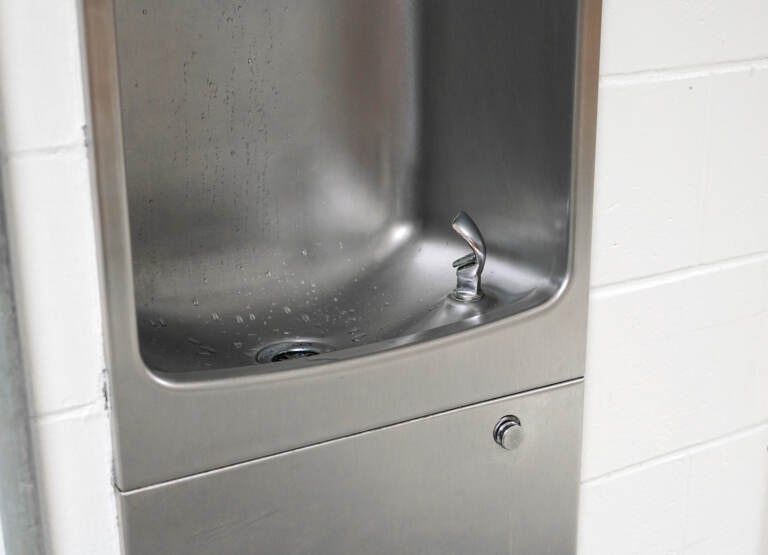What level is acceptable? Lead found in water at most Delaware schools
The state has lowered its threshold for using a fountain to 7.5 parts per billion. Parents and lawmakers questioned whether any level of lead is too much.
Listen 1:38
(bigimager/BigStock)
Nearly 150 spigots and faucets at 49 Delaware public schools had lead levels above the new shutoff threshold set by federal environmental regulators, an analysis by WHYY News shows.
That new threshold — 7.5 parts per billion — forced the state to order districts to shut off faucets or take other measures, including filters and signage, to prevent students, staff, and visitors at those 49 schools from drinking contaminated water. The old threshold — 15 parts per billion — had led only one school to shut off its fountains.
Lead was also detected above one part per billion — the safety threshold urged by the American Academy of Pediatrics — at 657 fountains and other water sources at 165 schools. That’s two-thirds of the state’s approximately 250 public K-12 schools.
Overall, lead was detected at any measurable level in a total of 888 sites at 180 schools, according to an analysis of a state report on testing that occurred from the fall of 2020 through this spring.
The revelations about lead in the water at schools up and down the state, coupled with the state’s admittedly inadequate release of information to the public, have triggered anger, dismay, and confusion among parents and lawmakers.
That frustration was on display Monday night during a two-hour Zoom forum hosted by state Sen. Sarah McBride and other legislative leaders.
More than one viewer commented that the Delaware National Guard should visit every school that exceeded the 7.5 parts per billion threshold to test students for lead exposure and to hand out bottled water.

Others castigated state education and health leaders for taking a lackadaisical attitude about informing the public, and for not having an urgency to solve the problem. Some called for major capital projects to replace piping at affected schools, many of them more than a half-century old.
Some environmental advocates, such as Amy Roe of Lead-Free Delaware, insist that the new threshold still leaves thousands of children at risk. She cited a 2016 statement from the American Academy of Pediatrics urging that “state and local governments should take steps to ensure that water fountains in schools do not exceed water lead concentrations” one part per billion.
“Any water sample that is higher than the American Academy of Pediatrics recommendation is very worrisome,” Roe said last week, and she expressed the same sentiment during the meeting that had nearly 300 attendees.

The threshold for bottled drinking water, set by the U.S. Food and Drug Administration, is 5 parts per billion.
Sen. McBride wondered why the threshold isn’t lower than 7.5 parts per billion for lead, which can cause developmental delays and other adverse health impacts on children.
“Why are we not utilizing a goal that is at zero or one part per billion or five parts per billion,’’ McBride asked, adding that it “seems to me that we should be striving to hold ourselves to high safety standards.”
Bill Richardson, a scientist with the U.S. Environmental Protection Agency, said during the meeting that 15 parts per billion is the federal government’s threshold for remedial action for lead in water. He didn’t specify why 7.5 parts per billion is the new threshold, only that it was selected “out of an abundance of caution.”
No concern ‘children have been exposed to catastrophic lead levels’
Molly Magarik, secretary of the Department of Health and Social Services, said she doesn’t suspect that children have been poisoned by the water in schools. She noted that lead is often contained in water pipes in private homes, and even in food, and urged concerned parents to discuss testing and screening for lead contamination with their pediatrician.
“There is not a widespread recommendation or a concern at a population health level that students have been exposed to catastrophic lead levels such that universal testing and screening would be recommended,’’ Magarik said.
Officials also noted that many of the sites with levels above 7.5 parts per billion were not used for drinking, such as spigots outside buildings, or hand sinks in restrooms or classrooms. An analysis found that 99 of those 149 sites were considered “consumption points,’’ according to the state report.
During the session, Education Secretary Mark Holodick took responsibility for the clumsy way the state informed the public. Holodick aide Jamie Mack had told the audience that “the results were communicated to maintenance leads in the districts.’’
Many in the audience said that was inadequate, and Mack and Holodick agreed. Before taking over the Department of Education this year, Holodick had been superintendent of the Brandywine School District.
“Having been a superintendent, I can tell you that there are an awful lot of responsibilities that rest on the shoulders of facility chiefs,’’ Holodick said. “And so that communication should have gone to them, but it should have included a number of other people, and it should have been backed by very clear direction on what should be communicated to the families and staff in those schools. So we obviously fell short in our communication plan. It was not intentional.”
Holodick and Magarik pledged to be more forthcoming and to update the public regularly, including by improving information on a state website about the lead in school water. The testing was done with a $204,000 federal grant, but officials said they are committed to using state resources to do further testing and rectify the issues.
State Rep. Melissa Minor-Brown, the new majority whip, told the bureaucrats that she understands what parents are feeling, noting the flurry of remarks in the “chat’’ section of the Zoom meeting.
“What I am seeing is that parents and families are scared,’’ she said. “They’re worried and they feel that there’s a lack of trust. Parents are sending their kids to school five days a week and they’re trusting that the priority is their children and the health of their children. And the same with the staff in the schools.
“So I think it’s important that people on this Zoom walk away feeling confident that their health, their welfare, their children’s health, their family’s health, is the priority moving forward.”
WHYY is your source for fact-based, in-depth journalism and information. As a nonprofit organization, we rely on financial support from readers like you. Please give today.







